Herpes Zoster: Classic and Unusual Manifestations
Herpes zoster is a painful, blistering rash that typically manifests in a dermatomal distribution and is caused by reactivation of varicella-zoster virus infection. A classic presentation of herpes zoster involving the right T4 dermatome is illustrated in Figure 1. The patient was a 90-year-old man who experienced severe pain on the right side of his neck and chest followed by development of maculopapular lesions. The lesions, which ranged from macular to vesicular, resolved with no scarring or postherpetic neuralgia following 10 days of therapy with oral acyclovir and intramuscular injections of γ-globulin.
Herpes zoster is a painful, blistering rash that typically manifests in a dermatomal distribution and is caused by reactivation of varicella-zoster virus infection. A classic presentation of herpes zoster involving the right T4 dermatome is illustrated in Figure 1. The patient was a 90-year-old man who experienced severe pain on the right side of his neck and chest followed by development of maculopapular lesions. The lesions, which ranged from macular to vesicular, resolved with no scarring or postherpetic neuralgia following 10 days of therapy with oral acyclovir and intramuscular injections of γ-globulin.
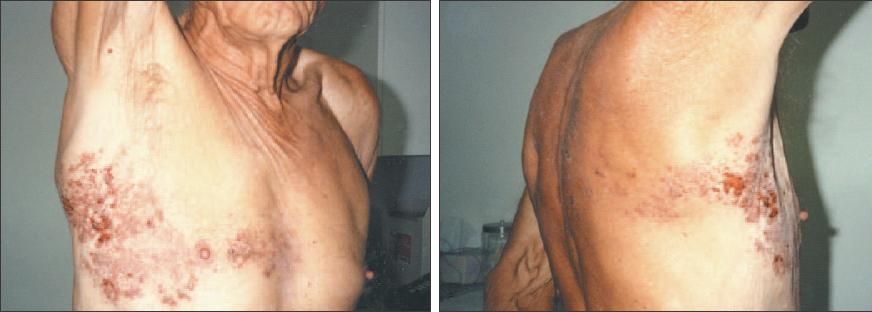
Figure 1 –These images illustrate a classic rash indicative of herpes zoster.
The location of the macular and vesicular lesions suggests involvement of the T4 dermatome. (Images and case supplied by William A. Hayes, MD.)
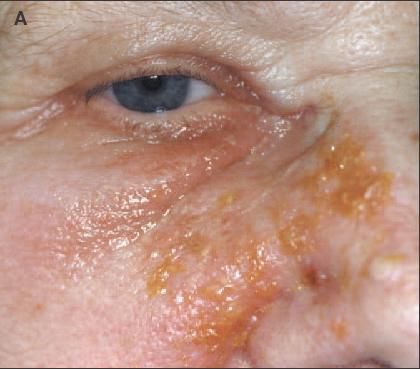
Figure 5 –
Measurement of herpesvirus titers in this patient confirmed that this ruddy, pruritic vesicular rash was herpes zoster and not another disease entity (A). Complicating the diagnosis of herpes zoster was the presence of molluscum contagiosum on the patient's forehead (B). (Images and case supplied by Leslie Trope, MD, and Glen Marin, MD.)
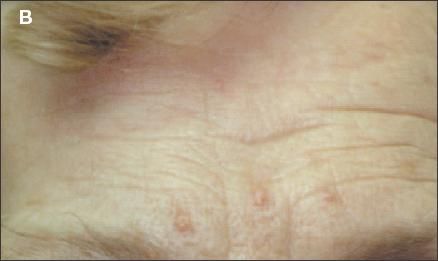
Figure 5 –
Measurement of herpesvirus titers in this patient confirmed that this ruddy, pruritic vesicular rash was herpes zoster and not another disease entity (A). Complicating the diagnosis of herpes zoster was the presence of molluscum contagiosum on the patient's forehead (B). (Images and case supplied by Leslie Trope, MD, and Glen Marin, MD.)
Figure 2 also depicts herpes zoster involving the T4 dermatome, but the T10 dermatome is involved as well. Typically, a single dermatome is affected; involvement of 2 distinct dermatomes is rare. This case occurred in a 66-year-old man who had been hospitalized because of left-sided chest pain. Cardiac evaluation revealed no abnormalities. The patient was discharged; however, that evening, painful, vesicular lesions on erythematous bases simultaneously began to develop along the left T4 and T10 dermatomes. The pain and rash resolved within a week of management with acyclovir at a dosage of 800 mg qid.

Figure 2 –
Depicted is a rare case of herpes zoster involving 2 dermatomes: the left T4 and T10. (Image and case supplied by Edwin J. Masters, MD, and J. Patrick Downey, MD.)
Another unusual case of herpes zoster is depicted in Figure 3. When vesicles developed on the right sole of a 35-year-old man, he thought he was having a recurrence of athlete's foot. The pain and tenderness in the area suggested herpes zoster. Note that the vesicles and erosions correspond to the S1 dermatome.
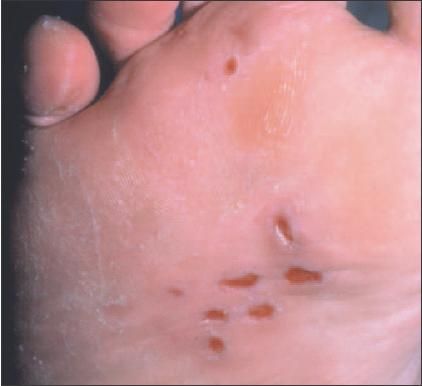
Figure 3 –
This presentation of herpes zoster resembles athlete's foot. (Image and case supplied by Mark Popkin, MD.)
The diagnosis of herpes zoster was confirmed by the presence of multinucleated giant cells in a Tzanck smear taken from the floor of the vesicle. The pain and rash promptly resolved following administration of acyclovir. The unusual presentation of herpes zoster and the relatively young age of the patient raised suspicion of immunocompromise. Indeed, a presentation such as the one described here can be the first sign of HIV infection, although no underlying immunosuppressive disease was found in this patient.
Herpes zoster ophthalmicus
The course of herpes zoster is usually benign, but serious complications can occur. One such complication is blindness, which can result (in severe cases) when herpes zoster involves the ophthalmic branch of the trigeminal cranial nerve (associated with the V1 dermatome), as illustrated in Figure 4. This nerve is involved in about 10% of herpes zoster cases. Lesions on the tip of the nose (Hutchinson sign) are an important clinical and prognostic clue indicating that the nasociliary nerve and possibly the eye are affected. Indeed, ocular complications develop in about 50% of patients with herpes zoster ophthalmicus. Typically, the conjunctiva is red and swollen, and keratitis manifests. Rarely, uveitis develops, leading to secondary glaucoma. In addition to loss of vision, ocular complications include neuroparalytic keratopathy, Adie pupil caused by ciliary-ganglion damage, ophthalmoplegia, and optic nerve involvement.
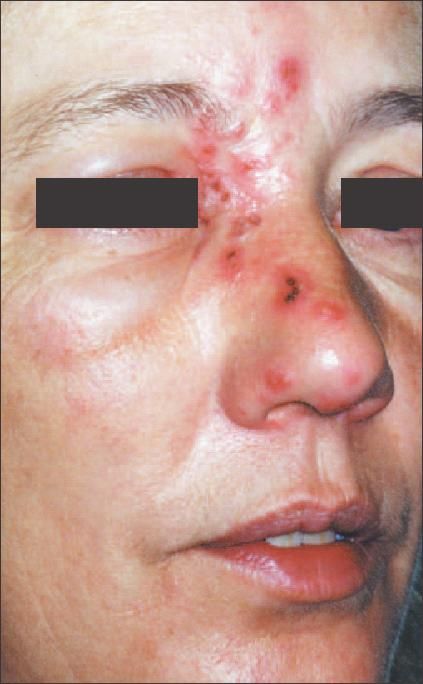
Figure 4 –
This illustration of herpes zoster ophthalmicus shows the telltale involvement of the nasociliary nerve (Hutchinson sign). (Image and case supplied by Sunita Puri, MD.)
The case of herpes zoster ophthalmicus developed in an otherwise healthy 40-year-old woman. She presented with an asymptomatic rash on her forehead and nose that had developed 2 days earlier and erythema of the right eye. Antiviral therapy was started immediately, and the patient was referred to an ophthalmologist for evaluation and intervention regarding optical injury.
Despite the proximity to the eye, the herpes zoster rash shown in Figure 5A that developed in a 73-year-old woman did not include ocular involvement. Complicating the diagnosis, however, was the presence of a rash on the woman's forehead, which was determined to be molluscum contagiosum (Figure 5B). (Note the classic umbilicated papules, not to be confused with herpetic vesicles.)
The rash, which developed near the right eye, was pruritic and painful and had a somewhat ruddy, vesicular appearance. It could have been mistaken for acne rosacea or the type of rash that can occur in patients with systemic lupus erythematosus, although those types of rashes usually have a bilateral distribution. The patient was found to have an elevated herpesvirus titer. The rash resolved following acyclovir therapy.